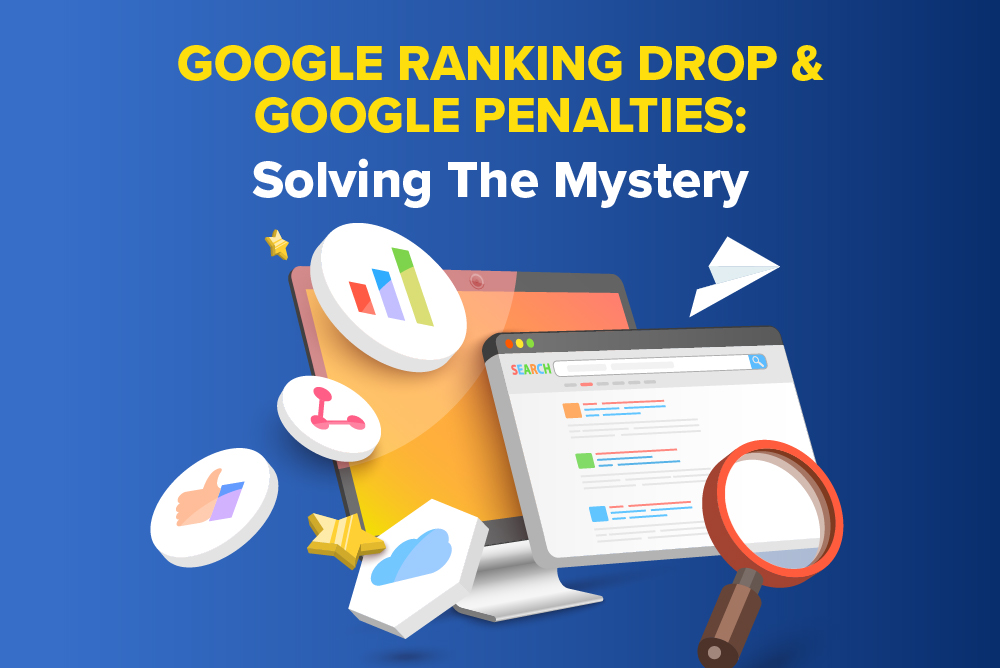The digital marketing world can feel like every man for himself. With half of all marketers believing that Search Engine Optimisation (SEO) is the most effective online marketing strategy, competition for search engine “real estate” has never been so fierce.
Such stiff competition for search engine ranking has led many marketers to succumb to pressure to increase ranks at any cost. In response, some use shady tactics to help their business get ahead on the SERPs of major search engines. This has led to a differentiation of SEO strategies – Black Hat vs White Hat SEO. Our SEO agency experts discuss what separates White Hat from Black Hat SEO tactics.
Black Hat SEO: Going Rogue
Black Hat SEO tactics use shortcuts and attempted hacks to manipulate search engines. In hopes of higher rankings and more traffic, some site owners cater their SEO techniques to these bots rather than real people. It’s usually executed in hopes of short-term gains rather than playing the long game, as seen in White Hat strategies.
Google is highly aware of these Black Hat SEO techniques, and its algorithms have evolved to spot them. Offenders get penalised for bad SEO practices, so if these manipulative tactics sound familiar, watch out! These are some strategies that are commonly used:
1. Keyword Stuffing
The black hat practice of placing keywords where they don’t belong is one of the most prevalent Black Hat SEO techniques. If keywords a site is trying to rank for are unnaturally shoved in throughout content and meta tags, that’s keyword stuffing. What does it look like? Google provides a pretty good example:
We sell custom cigar humidors. Our custom cigar humidors are handmade. If you’re considering buying a custom cigar humidor, please contact our custom cigar humidor specialists at [email protected].
Keyword stuffing ultimately aims to signal a web page’s relevance for a keyphrase to major search engines via brute force. Yet, this results in poor user experience with no value being given to readers of the content.
2. Cloaking
Keyword stuffing isn’t always that obvious. Some Black Hat aficionados obscure keywords with white text or hide them altogether with CSS coding. In doing so, these websites could have invisible keywords en masse without ever affecting how the user perceived the website. Simply put, they would list a keyword 1000 times or more on a page while disguising it as white space.
Another version of cloaking involves masking the true nature of a page. This can be baiting visitors with keywords, then redirecting to another site, or showing HTML to search engines and Flash images to users. You’re showing one thing to search engines and another thing to visitors. It sounds like a nasty magic trick, but it’s a common Black Hat SEO tactic.
For either form of cloaking, search engines have become proficient at picking out this black hat strategy and actively penalising it.
3. Link Spam
Spamming links is a classic Black Hat SEO link-building technique. Link schemes emerged when early marketers realised that Search Engine Algorithms rewarded link quantity. As such, they innovated and found ways to plant many inbound links to their website from all over the web. This way, websites with thin or irrelevant content could rank for a key phrase provided enough links were built.
Spamming links with irrelevant keywords as the anchor text was even possible. So long as the page received more links than competing pages, it would outrank in search engines. This was further empowered by creating private blog networks (PBN) and using these to deliver powerful links from websites with little to no actual human users. Even where web admins did not have PBN, they would actively work with vendors who sold these unnatural links.
4. Duplicate Content
Stealing other people’s content is unethical. This could look like direct copy/pasting content from another site or making slight modifications to make it appear original. While citing references and getting your theories from credible sources is good, completely lifting content is a strict no-no.
This is because plagiarism is against copyright law. If you do this, you risk legal action and fines. A better alternative to creating relevant content that is not duplicated is to use high-quality content creation tools. These will allow you to create unique content without lifting anything from elsewhere.
5. Review Spam
You may have heard about review spam. This is where businesses pay to promote positive reviews on third-party platforms. They often buy fake accounts to leave positive reviews on popular social media sites. After this, these fake reviews are reposted to the website as proof to audiences.
Naturally, these fake reviews are usually written by paid reviewers who don’t know the product. As such, without first-hand experience, they often create shallow reviews that add little value to readers.
The Google July 2022 Product Reviews update was rolled out to combat review spam to promote real reviews that go above and beyond the templated information found online. This thus devalued reviews that did not provide strong value to readers.
White Hat SEO Techniques – Playing by the Rules
White Hat is your way into Google’s “good books”. It means you optimise search engines according to Google’s guidelines with a long-term plan to make your site the best. Operating according to White Hat principles protects you from ensures you are in line with Google algorithm updates, helping you avoid penalties that affect your ranking.
One of the primary differences between Black Hat and White Hat approaches is their approach to link building. Black Hat SEO techniques may involve buying links, creating link farms, or participating in link exchanges, which artificially inflate the number of links pointing to a website. However, these techniques are typically viewed as manipulative and can lead to penalties from search engines.
On the other hand, White Hat SEO prioritises creating high-quality content and optimising user experiences, such as fast load times, intuitive navigation, and visually appealing design. By focusing on providing value to visitors, White Hat SEO strategies aim to attract natural backlinks from other reputable websites, which can help improve the website’s search engine rankings in the long run.
Here are some commonly used strategies to execute White Hat SEO for your site:
1. Providing the Ideal User Experience (UX)
The cornerstone of White Hat Techniques is giving site visitors the best possible experience on your website. Google has always steered site owners towards focusing on designing for UX. The only difference is that their algorithms can better separate the good from the bad.
From load speeds to easy navigation and intuitive interfaces – UX is a great decider of rankings. As it’s a top priority in Google’s software, it makes sense that UX would come first on our White Hat SEO strategy list.
2. High-Quality Content
White Hat SEO techniques prioritise creating high-quality content to ensure that a website ranks well in search engine results pages. Websites can attract natural backlinks and improve rankings over time by creating content that engages readers, answers their questions, and delivers real value.
White Hat SEO strategies also ensure that content is optimised for search engines by using relevant keywords, meta descriptions, and title tags. Unlike Black Hat techniques, which may stuff keywords or use hidden text to manipulate search engine algorithms, White Hat techniques use these elements naturally and organically, enhancing the user experience and improving the website’s relevance to specific search queries.
White Hat SEO techniques emphasise creating original content that is not plagiarised from other sources. This ensures that the content is unique and valuable to readers, which can lead to increased engagement and social sharing, further boosting the website’s rankings.
By creating high-quality content optimised for search engines naturally and organically, White Hat SEO strategies ensure that websites can improve their rankings sustainably and ethically while delivering value to their readers.
3. Mobile-First Optimisation
Optimising your website for mobile browsing has become even more crucial in recent years. This is because mobile-first indexing remains the standard search engine protocol. Simply being mobile-friendly is no longer enough, as statistics show that mobile usage continues to grow and dominate the digital landscape.
As of February 2023, mobile devices account for over 60% of all internet traffic worldwide. This trend has been driven by the increasing adoption of smartphones, which have become essential to people’s daily lives. As a result, mobile searches have continued overtaking desktop searches, with 63% of all Google searches originating from mobile devices.
Mobile users have higher expectations for website speed and usability. Research shows that 53% of mobile users will abandon a website if it takes longer than three seconds to load. This means optimising your website’s mobile experience, including fast load times, easy navigation, and responsive design, is more critical than ever.
That’s why optimising your website for mobile browsing is not just a leading priority for site owners but a necessity in today’s digital landscape. With mobile usage continuing to grow, providing a seamless mobile experience for your users to stay competitive and meet their expectations is essential.
4. Link Building
Google’s algorithm updates have continued to prioritise quality content and links. In 2022, Google’s search algorithms used over 200 ranking factors to determine the relevance and authority of a website. One of the most significant factors is the quality of links pointing to a website.
Links from high-quality websites have a significant impact on a site’s search engine rankings. Websites with more high-quality links have a higher average search engine ranking. In contrast, sites with many low-quality links experienced a drop in rankings.
Google’s algorithms have also become more adept at detecting and penalising manipulative link-building tactics. Spammy links and manipulative tactics such as private blog networks (PBNs) and paid links remain significant problems. However, more website owners and SEO professionals prioritise ethical and sustainable link-building practices.
Building high-quality, relevant links through ethical means remains a crucial aspect of SEO in 2023. Website owners and SEO professionals should focus on developing valuable content and building relationships with other websites in their industry. This will help them earn natural, high-quality links to improve their search engine rankings and drive organic site traffic.
Black Hat SEO Vs White Hat SEO
As we’ve seen, many different types of Black Hat techniques exist. However, some are far riskier than others. For example, if you’re going to try and game the system by cloaking, you’ll likely end up getting caught. The same goes for duplicate content. You may think copying someone else’s content is fine, but it’s quite risky.
It can be tempting to take the game into your own hands. Remember that Black Hat SEO strategies might pay off quicker, but the positive effects won’t last. A good rule of thumb is to follow Search Engine Guidelines. They focus on serving users to the best of their ability, so in principle, you should too.
Keen to have industry-leading white hat SEO practices for your website? Speak to the experts at Singapore’s leading SEO services agency – First Page Digital. Our SEO specialists apply an array of white hat techniques to ensure that your website is never at risk of being penalised by search engines while steadily moving up the SERP for your keywords.
If you’d like to learn more about the best SEO practices today and how to get started for free, check our recent blog, Best Free SEO Resources And News Platforms For Marketers.







![Why Is SEO Expensive? A Realistic Review Of SEO Pricing In Singapore [2024]](https://www.firstpagedigital.sg/wp-content/uploads/2023/12/SEO-Pricing.jpg)









